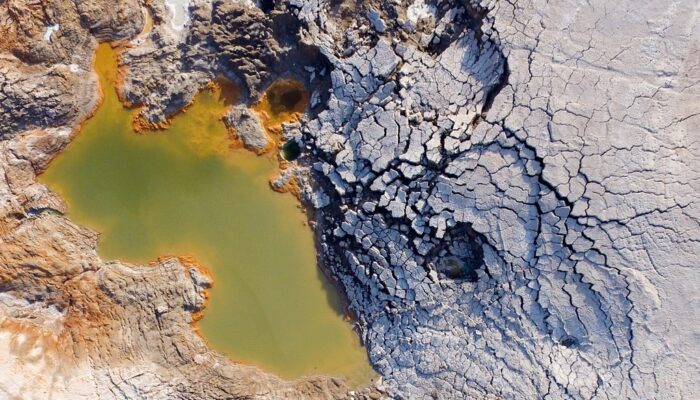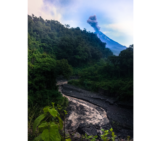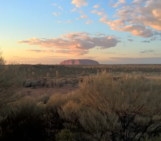
This photo, captured by drone about 80 metres above the ground, shows a nested sinkhole system in the Dead Sea. Such systems typically take form in karst areas, landscapes where soluble rock, such as limestone, dolomite or gypsum, are sculpted and perforated by dissolution and erosion. Over time, these deteriorating processes can cause the surface to crack and collapse.
The olive-green hued sinkhole, about 20 m in diameter, is made up of a mud material coated by a thin salted cover. When the structures collapse, they can form beautiful blocks and patterns; however, these sinkholes can form quite suddenly, often without any warning, and deal significant damage to roads and buildings. Sinkhole formations have been a growing problem in the region, especially within the last four decades, and scientists are working hard to better understand the phenomenon and the risks it poses to nearby communities and industries.
Some researchers are analysing aerial photos of Dead Sea sinkholes (taken by drones, balloons and satellites, for example) to get a better idea of how these depressions take shape.
“The images help to understand the process of sinkhole formation,” said Djamil Al-Halbouni, a PhD student at the GFZ German Research Centre for Geosciences in Potsdam, Germany and the photographer of this featured image. “Especially the photogrammetric method allows to derive topographic changes and possible early subsidence in this system.” Al-Halbouni was working at the sinkhole area of Ghor Al-Haditha in Jordan when he had the chance to snap this beautiful photo of one of the Dead Sea’s many sinkhole systems.
Recently, Al-Halbouni and his colleagues have employed a different kind of strategy to understand sinkhole formation: taking subsurface snapshots of Dead Sea sinkholes with the help of artificial seismic waves. The method, called shear wave reflection seismic imaging, involves generating seismic waves in sinkhole-prone regions; the waves then make their way through the sediments below. A seismic receiver is positioned to record the velocities of the waves, giving the researchers clues to what materials are present belowground and how they are structured. As one Eos article reporting on the study puts it, the records were essentially an “ultrasound of the buried material.”
The results of their study, recently published in EGU’s open access journal, Solid Earth, give insight into what kind of underground conditions are more likely to give way to sinkhole formation, allowing local communities to better pinpoint sites for future construction, and what spots are best left alone. This study and further work by Al-Halbouni and his colleagues have been published in a special issue organised by EGU journals: “Environmental changes and hazards in the Dead Sea region.”
By Olivia Trani, EGU Communications Officer
Imaggeo is the EGU’s online open access geosciences image repository. All geoscientists (and others) can submit their photographs and videos to this repository and, since it is open access, these images can be used for free by scientists for their presentations or publications, by educators and the general public, and some images can even be used freely for commercial purposes. Photographers also retain full rights of use, as Imaggeo images are licensed and distributed by the EGU under a Creative Commons licence. Submit your photos at http://imaggeo.egu.eu/upload/.




